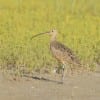 By Jim Stevenson
By Jim Stevenson
The initial Sunday field trips turned out to be really, really birdy, from the gobs of waterbirds at San Luis Pass to the many warblers at Laffite’s cove. Most favorite was a male Canada Warbler in my yard. We will have another one next Sunday. 8:30 to noon, $25. We’re coming into the height of the fall migration. Down below is a list of some of what we saw. Folks, I know I said to take your time, but please think about the “calendar” sale that’s attached. I’ve blocked off September to take care of this. All the directions are right there. The gallery is on sandpipers, especially matters of molt and ecology. Enjoy!
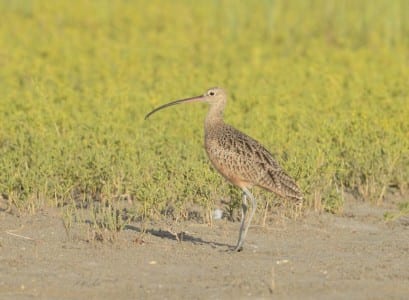
Sandpipers are an amazing group of waterbirds, best known for their bills and varying sizes. Most also have long migrations, easily accomplished by their fantastic powers of flight. This may be the king of the sandpipers, the Long-billed Curlew, a breeder of the short-grass prairies of the American West. They winter in decent numbers on the Texas Coast, where they probe for fiddler crabs with their amazing beak. These females have longer bills than their conspecific males.
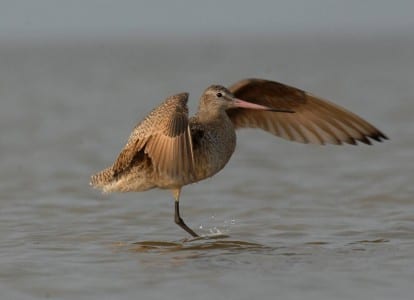
One of our rarest birds is the one-legged godwit. OK, ha ha. This is the Marbled Godwit, and my humor hardly has a leg to stand on. In fact, it’s downright crippling. Godwits’ bills curve up; curlews curve down. The term “marbled” refers to the pattern, but they lose it partially when they come for the winter. Curiously, some godwits and curlews aren’t returning to the West to breed, and I hope that doesn’t spell trouble for the species. Curlews, especially, are declining. Some summer here on the Island.
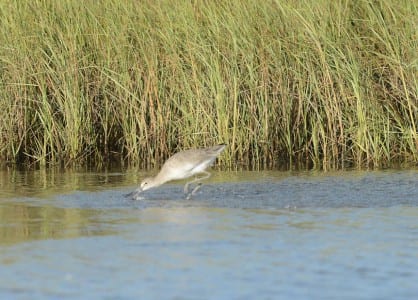
Willets are almost as large as godwits and curlews but have a straight bill. I’m not sure I’ve ever seen one feeding in this manner, racing their bill into surface-feeding fish. I have seen yellowlegs and phalaropes doing this, so I suppose it’s possible. Aparently. I believe this is a Western Willet, BTW, as it seems fairly slender and long-billed; and it’s a little late for Eastern to be here, anyway.
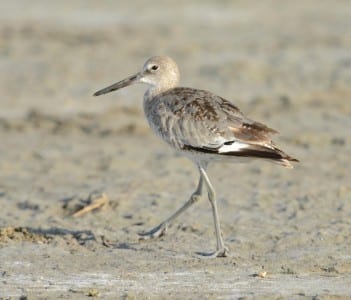
This Western Willet is in the throws of molting and is still showing off its breeding plumage. Note the long legs and bill, a sure sign of Western. We always have Willets in Galveston, but in spring and summer, they’re usually on the Bay side (Easterns), and in fall and winter they’re usually on the Gulf side (Westerns). And I strongly suspect they’ll be separated into two species in the next few years.
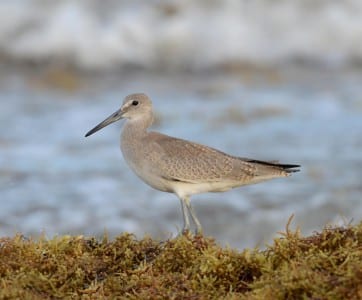
This is a fairly young Western Willet (I think!), judging by the slender form, and habitat. Early fall is fraught with all kinds of unfamiliar plumages in birds, due to both molt as well as very young birds. We also get wanderers in our midst more than many realize, and vagrant subspecies may be bewildering. Have you ever seen a Willet that looks like this?
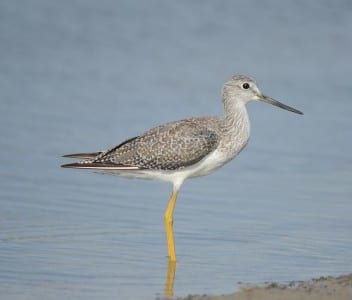
Greater Yellowlegs show up for the duration of the year, until they leave in spring for their northern nesting grounds. They become tame and really loud! Aside from how big it is, notice how the bill is very much longer than the head. This bird is a juvenile Greater, as the streaking on the breast stops rather abruptly, like a Pectoral Sandpiper. However, the bill has already attained much of the adult dark pigment, with just a little light color at the base. So, it’s prolly 3 months old, or so.
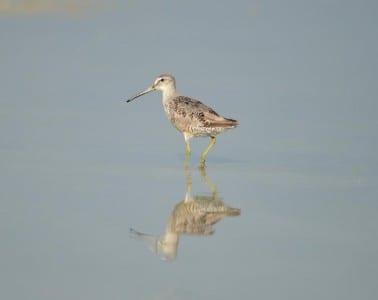
Dowitchers are the snipes of salt water. This is actually the short-billed, as a female longbilled reeeally has a long bill! Note the yellowish legs of a dowitcher, and the breeding plumage barring is giving way to the flat gray of winter. A better sign of its species is the faint streaking you see on the side of the head. But the vast majority of dowitchers in salt water are Short-billed. These are one of the many “medium-sized” sandpipers.
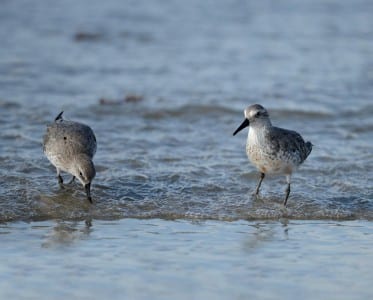
Yet another “robin-sized” sandpiper is the knot. Red Knots are decreasing abruptly, at least partly because of the harvesting of horseshoe crab, taking away their eggs that feed the knot in the migration. The right bird shows remnants of the rufous of the breeding plumage and the left bird shows just a bit of the dark spots on its back also leftover from that alternate plumage. When reading, remember that alternate, breeding and summer plumage all mean the same thing. It’s like basic, non-breeding and winter plumage all mean essentially the same thing.
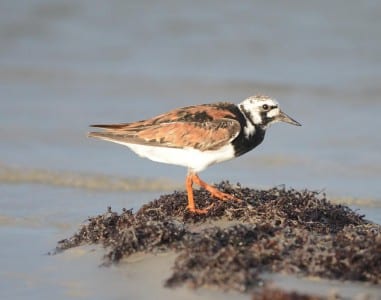
Yet another medium-sized sandpiper is more a plover in pattern and behavior. The Ruddy Turnstone works beaches for arthropods and is checking out this old sargassum clump for goodies. The wedge- like bill is ploverish but on rocky coasts it allows them to break into barnacles and extract the soft-bodied crustacean living within. Obviously, this bird still hasn’t given up its breeding colors, and who can blame him?
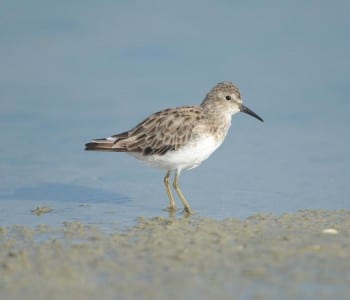
The World’s smallest waterbird is the Least Sandpiper, really seen more often slightly away from water than here on the shore. Notice the thin, very slightly decurved bill and mildly yellow legs. It has lost most of the brown of breeding plumage, but is still more richly colored than the Westerns with whom it’ll be wintering.
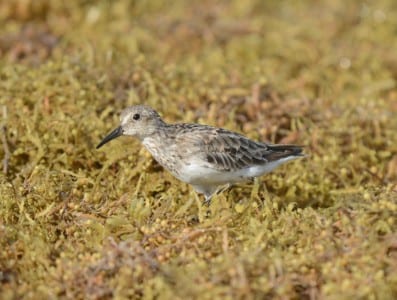
There is quite a bounty of life in the sargassum that washes in, coming from the middle of the Atlantic and diagonally across the Gulf. Those little round things are gas bladders that keep the mass afloat, so the plant can photosynthesize. Quite a number of echinoderms, mollusks, flatworms (like slugs) and arthropods inhabit these clumps and picking through them is fun, educational and fascinating. As a former mar ine biology teacher, I find these a self-contained laboratory of marine invertebrates. Oh, I forgot. The bird is a Least Sandpiper, losing its brown from spring and summer.
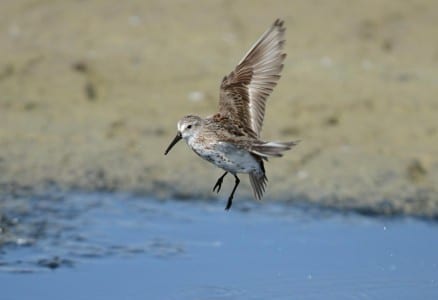
Like Superman swooping in to save the World, this Western Sandpiper sails out of space to rid the world of tiny, marine invertebrates. Like so many birds this time of year, it is in that gray twilight between breeding plumage and the drab, gray basic garb of winter. The majority of its red has disappeared and the cute little chevrons underneath are beginning to take their seven month vacation as well. Left will be our Hemisphere’s most abundant bird, in flocks of one of our drabbest creatures.
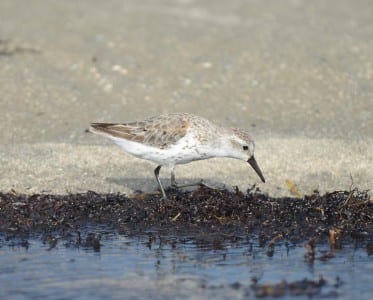
Another Western Sandpiper a bit further along into winter plumage. You can see the long bill. Not being very decurved on the tip, I suspect a male. I think it’s picking up miniscule copepods, but he’s really busy! All that decomposing plant life invites the vultures of the bug world to feed and reproduce in the masses of rot. It all kinda reminds me of the story about the hotel manager who realized someone was hiding in one of his rooms. He raced up the stairs and opened the door, only to find Ludwig Beethoven himself, sitting at the desk and erasing notes off the Ninth Symphony. The shocked employee gathered himself, and in a shaky voice quivered, “Sir, what are you doing?” The ancient musician looked up slowly and proclaimed, “I’m decomposing.” Have a great week.

 Posted in
Posted in 
























Wonderful beat ! I wish to apprentice whilst you amend your web site, how could i subscribe for
a blog website? The account aided me a applicable deal.
I were tiny bit familiar of this your broadcast provided bright transparent concept
Good article. I’m experiencing a few of these issues as
well..
I am genuinely delighted to read this weblog posts which consists of tons of
useful data, thanks for providing such data.